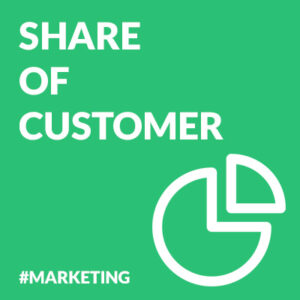 In this article, you’re going to learn how to increase profit by growing your customer share.
In this article, you’re going to learn how to increase profit by growing your customer share.
I’ll tell you two things:
(1) Why focusing on share of customer is surprisingly better than increasing market share.
(2) 5 awesome techniques you can use to boost your customer share.
(All of this illustrated with real-life examples.)
The first sale is the hardest
When you want to sell a product to new prospects, your most difficult task is to win their trust. Your prospects need to trust you before buying from you. They must believe your story.
(Here‘s a good framework to improve your marketing storytelling.)
So once you made the first sale, you’re done with the hardest part your job.
From now on, the following sales will cost you less. Your customers have demonstrated a real interest in what you have to offer. They now have fewer reasons to hesitate.
Why? Because your customer believes in you. You have sold him something; it has proved to be all you claim for it; therefore he feels safe in trusting anything you may say to him in the future.
— Robert Collier, copywriter and author of The Robert Collier Letter Book
If you keep delivering what you promise and more, they’ll keep doing business with you.
Customer Share vs Market Share
There’s a big difference between customer share and market share:
Market-share strategy = Trying to get a little bit from a lot of customers
Customer-share strategy = Focusing on getting as much as possible from fewer customers
It is cheaper to retain existing customers than acquire new ones.
(Which means higher gross margins.)
(Which means more profit.)
(Which means a growing business.)
Knowing that, it’s wiser to focus on encouraging your customers to be more loyal. Trying to get a larger share of the market will cost you more and make you lose an unfair advantage: existing customers who have already made the decision that it was worth buying from you.
Bonus:
Your most loyal customers tend to be your greatest salespeople.
Increase the share of wallet
Share of wallet refers to the amount of your customers’ total spending within a product category that your business captures with the products and services that it offers.

A higher share of wallet means that your customers are spending more money to buy your products than to buy your competitors’ products.
As an example, The Coca-Cola Company talks about “share of stomach”, i.e. the ratio of Coca liquids that you drink vs. the competition’s.
Here’s a big question:
Adopting a strategy requires you to make choices.
Do you want to invest in acquiring more customers or in making sure that your existing customers keep buying more from you?
Now, I’m going to share great examples of the customer-share strategy.
Following the success of this article, I published The Value Mix. This new book helps you create successful propositions by leveraging the concept of customer share and 7 complementary frameworks.
1. Consistency: Fans of your products
What it is:
Consistency is about always showing up in a predictable way. That’s how brands are built.
It’s one of the key drivers of retention. Once your customers took the risk to try your product once, they want to be able to predict what will be the experience of coming back.
How it works:
GoudronBlanc, a sustainable fashion brand I founded in 2012, offers high-quality T-shirts for men made using organic cotton.
We do one thing very well: great T-shirts.
This is our focus.
It’s niche. But our customers love us for that. And they keep buying from us.
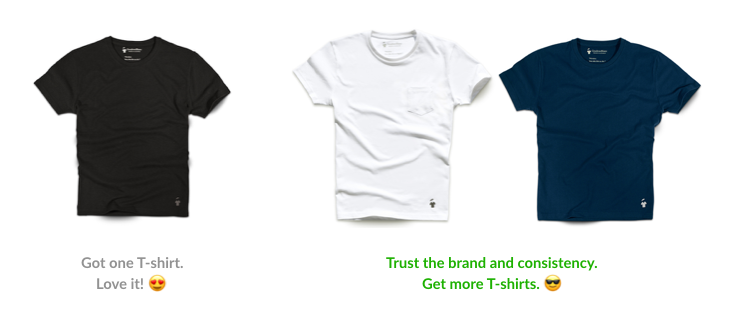
The brand doesn’t have an aggressive acquisition strategy. Instead, we focus on delivering the best to our existing customers. Since they are happy with what we do, they keep coming back to us.
But that’s not it!
What’s great is that they encourage their friends to have a look at our online shop. I am very proud of this, as it makes me happy to hear they’re happy about our work.
This strategy is a great example of being laser-focused on consistency to increase customer share.
2. Membership: A way to keep your customer hooked
What it is:
Membership is the state of belonging to a group of people that have access to special benefits. It’s about rewarding members—i.e. your most loyal customers—with special offers others—non-members—cannot have.
How it works:
One of Amazon’s biggest win as a retailer is the Amazon Prime membership.
According to a study by Consumer Intelligence Research Partners, Prime members shop more than non-members:
Prime members spend an average of $1,400 per year vs. $600 for non-Prime customers
Prime members shop on Amazon 26 times per year vs. 14 times for non-Prime customers
By giving access to free delivery and unlimited video and music streaming, Amazon rewards its most loyal customers.
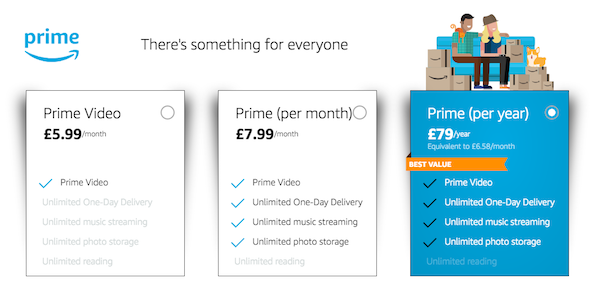
And the customers who subscribe to Amazon Prime?
They love it! So every time they want to buy something, they think “Amazon!”.
Rewarding the most engaged group of customers matters.
Prime membership is not about getting more market share. It’s about getting a bigger share of customer.
3. Upselling: Make additional features more attractive
What it is:
Upselling is about encouraging your customers to purchase a comparable higher-end product than the one they are considering buying.
How it works:
You can encourage people to boost core features…
I went shopping with a friend recently.
He needed a new pair of glasses so we went to Cubitts, a shop in London.
There, he’d found glasses he liked.
So the sales assistant asked him: “Would you like thin blue light lenses? It’s £50 more.”
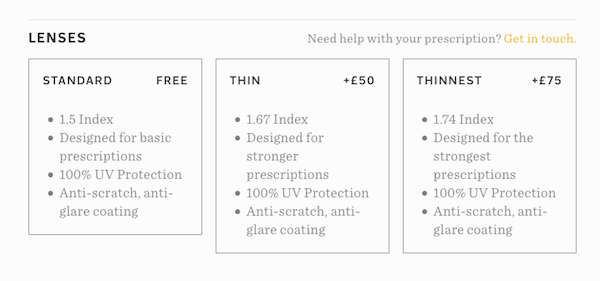
“Yes!”, he said as she was explaining that most opticians recommend these lenses when one works a lot with computers (which is the case for my friend).
Here was the upsell.
As a customer, my friend was happy. He got what he wanted.
An important takeaway about upselling:
You must focus on key features that make your products so much better in the eyes of your customers.
Here’s another example:
When you buy an iPhone XS on the online Apple store, you pick the basic version and then, you can select additional features, such as more memory.
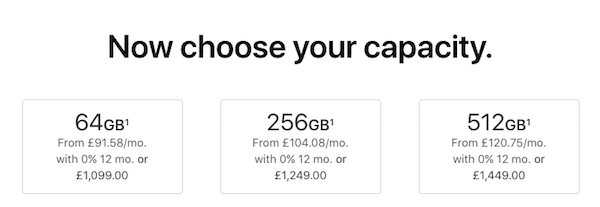
It’s a smart way to encourage their customers to play with the specs and be tempted, for example, to quadruple the storage of their new iPhone for £150.
You can make it slightly more expensive…
Starbucks has a pricing strategy based on upselling.
A tall latte (the smallest) is £2.10, while the venti size (the biggest, which is nearly twice as big) costs only £2.60.
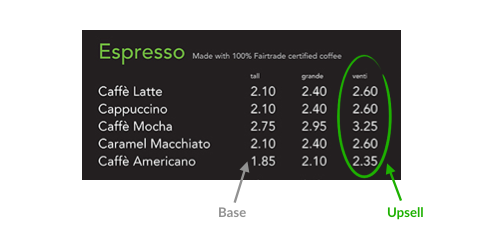
For an additional £0.50, you get twice the size.
Seems worth it right?
So when the barista asks their customers about the size, many go for the biggest, as it’s marginally not that much of a difference.
4. Series: Building anticipation into your products
What it is:
A series consists of a number of similar or related products, events, or experiences. They may share the same topic or theme and may also follow one another in a particular order.
This is a technique that authors and filmmakers use a lot.
Star Wars, Harry Potter, and FIFA (video game) are all series.
How it works:
Why are most successful authors and filmmakers creating series rather than standalone pieces?
Simple answer:
It’s just as hard for an author to sell a standalone book as it is to sell the first one of a series. But once they’ve managed to hook a customer into a series, this customer is more likely to buy all the books in that series.
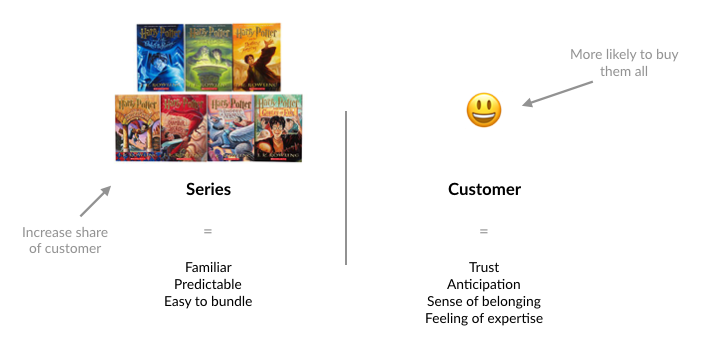
When J.K. Rowling publishes 7 books of Harry Potter, she does two things:
1. She increases her customer share, compared to a standalone book;
2. She increases a share of wallet (more below), as her readers are more likely to buy her releases of Harry Potter than another book.
5. Insurance: Creating peace of mind (at a premium)
Apple is a great example of a company that does upselling very well.
When you get a new iPhone or iPad, Apple offers AppleCare+.

It’s a technique for Apple to increase their share of customer.
Every time someone gets an iPhone or iPad, they are likely to consider a two-year insurance policy.
Airlines do that very well too.
They sell you travel and cancellation insurances. This is a clever way to make sure that they make more profit from each customer while providing additional peace of mind.
A higher gross margin is great!
It allows them to afford to spend more on acquiring new customers. So by increasing their share of customer, they get a stronger budget to increase later their market share.
A corollary of customer share: Increasing Customer Lifetime Value (LTV)
Focusing on the share of customer helps you increase retention.
If someone is happy to buy more from you, it’s likely that this customer will be more loyal.
And as the formula shows, better retention means better Customer Lifetime Value.
Following the success of this article, I published The Value Mix. This new book helps you create successful propositions by leveraging the concept of customer share and 7 complementary frameworks.
Customer share does win over market share
Instead of focusing on constantly acquiring new customers, why not spending more time and effort to delight your existing customers?
Think about making a profit in the long run.
Amazon, Starbucks, Apple, Uber, and Netflix… They all focus on increasing their share of customer. Market share is just the byproduct of their marketing strategy, not the other way around.
You cannot go wrong when your focus is on growing your share of customer.